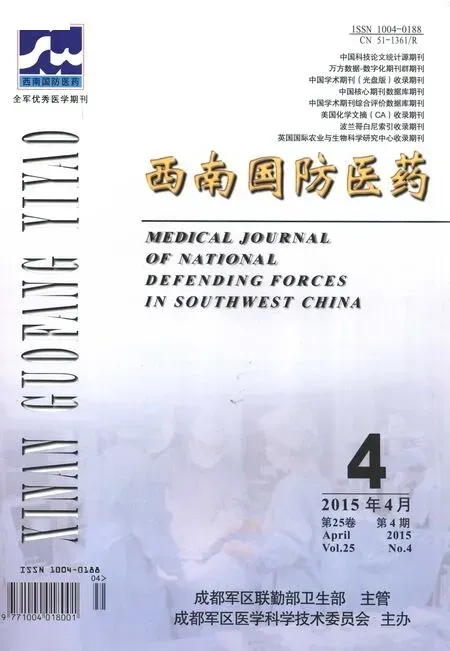丙肝病毒感染的肾移植受者的临床观察
作者单位:610021 成都,解放军452医院肾病内科
丙肝病毒感染的肾移植受者的临床观察
作者单位:610021 成都,解放军452医院肾病内科
张萍,段志强,杨丽南,阮一哲,徐海霞,彭燕,彭嘉丽,马小平
[摘要]目的对11例丙肝病毒感染的肾移植受者临床资料进行回顾性分析,为今后此类患者的诊疗提供指导。方法纳入2009年5月~2012年5月于我科行肾移植术的丙肝病毒感染患者11例,患者术前丙肝病毒RNA呈阳性、肝酶指标均正常。肾移植术后随访12~48个月,观察患者肝肾功能指标、丙肝病毒基因定量检测变化及排斥反应等发生情况。结果随访期间,所有11例患者中,3例在肾移植术后3 w~8个月出现不同程度的肝功能损伤,给予护肝治疗后肝功均恢复正常;2例发生移植术后新发糖尿病,给予适量胰岛素治疗后血糖水平均控制在正常范围内;4例于移植术后因丙肝病毒复制活跃使用干扰素联合利巴韦林抗病毒治疗,HCV-RNA病毒转阴,其余未抗病毒治疗的7例HCV-RNA较稳定,但仍为阳性,给予检测肝功及护肝治疗。随访期间无患者死亡及移植肾丢失。结论丙肝病毒阳性受者不再是肾移植手术的禁忌证,在进行肾移植术后,应严密监测肝功能及肝炎病毒复制情况。对于肝功能受损患者,应及时给予相应的治疗,并严密监测和处理高血糖等并发症。丙肝病毒阳性受者肾移植术后,短期存活率尚可,而长期存活率还需进一步观察。
[关键词]丙型肝炎;肝炎病毒;肾移植;并发症;预后
维持性血液透析患者是丙型肝炎病毒(HCV)感染的高风险人群,在HCV流行国家,血液透析患者感染HCV发生率高达50%[1]。即使在低发病率国家,如新西兰和英国,血液透析患者的HCV感染率为3%~5%,较一般人群高10倍[2-3]。血液透析患者的高HCV感染率与其免疫力下降、长期透析和反复输血相关。
研究显示,对于HCV感染的终末期肾脏病患者,采用肾移植替代肾功能治疗对其的生存利益大于血液透析治疗[4]。但有研究指出,合并HCV感染的肾移植受者与非HCV肾移植受者相比,短期、长期存活率及移植肾存活率均明显下降[5-6]。除了与HCV感染患者易合并心血管疾病、感染、败血症、蛋白尿等因素相关外,主要原因还在于移植后免疫抑制治疗会加速HCV复制并增加病毒负荷[7]。此外,此类患者移植后新发糖尿病(new-onset diabetes after transplantation, NODAT)的发生率也较非HCV感染患者明显增加[8-9]。因此,延长此类肾移植受者的长期存活是肾脏移植领域非常关注的问题,同时也是临床医生面临的一个巨大挑战。本研究回顾性分析了我院合并HCV感染的肾移植受者的临床资料,以期为临床提供诊疗依据。
1对象与方法
1.1研究对象 从2009年5月~2012年5月在我科行肾移植术的275例患者中,选取合并HCV感染的肾移植受者。入选标准:(1)抗HCV抗体阳性,HCV-RNA阳性,肝转氨酶正常,影像学及临床无肝硬化的表现。(2)排除合并乙型、丁型肝炎病毒感染者。(3)首次接受肾移植手术者。共纳入符合条件的研究对象11例,其中男性8例,女性3例,年龄35.7(23~51)岁。均接受的是健康尸体供肾。
1.2肾移植术后治疗术后均采用环孢素A+吗替麦考酚酯+泼尼松预防排斥反应。手术当日开始口服霉酚酸酯(MMF)1.5~2.0 g/d,环孢素A(CsA)起始剂量4~6 mg/(kg·d),随后根据血药浓度调整药物剂量。移植手术后前3 d静脉滴注甲基泼尼松龙(MP)0.5 g,之后改为口服泼尼松0.5 mg/(kg·d)维持,每周递减泼尼松5~10 mg/d维持治疗。移植术后定期检测患者肝功能,主要检测指标为丙氨酸转氨酶、天冬氨酸转氨酶、总胆红素、γ-谷氨酰转移酶。当肝功能出现异常时,及时应用护肝药物,同时调整免疫抑制剂用量和种类。HCV复制活跃且肝功能异常时,应用利巴韦林抗病毒;当出现血糖升高达到糖尿病诊断标准时,予以胰岛素治疗,将血糖控制在正常范围,同时调整免疫抑制剂剂量。
1.3随访出院后1个月内每周复查1次血尿常规,肝肾功能、血脂、血糖及环孢素A血药浓度;1个月后逐渐延长随访间隔,由1次/w延长为1次/2 w;3个月后,1次/月;6个月后,1次/2~3月。当肝功能出现异常时,及时复查HCV-RNA。
1.4观察指标
1.4.1急性排斥反应肾移植术后1 w内,受者出现发热、少尿、移植肾区疼痛,血肌酐每天升高26.5~44.2 μmol/L以上;结合移植肾超声检查排除梗阻、淋巴囊肿、尿外渗;根据环孢素A血药浓度排除环孢素A中毒等,必要时作肾活检明确诊断。
1.4.2慢性排斥反应移植后4个月~1年以上,受者缓慢出现水肿、蛋白尿、高血压、肾功能减退,内生肌酐清除率下降,血肌酐和尿素氮升高,尿量减少,甚至无尿,移植肾缩小变硬。
1.4.3人/肾存活率人存活时间指肾移植当日至受者死亡的时间;移植肾存活时间指移植当日至重新长期规律性血液透析治疗或受者死亡的时间。
2结果
2.1人/肾存活情况所有11例患者肾移植术后规律随访12~48个月,平均随访时间31.2个月,期间均未出现急性排异反应,人、肾存活情况良好。
2.2并发症情况 11例患者移植术后,3例出现肝功能异常,以ALT升高为主(ALT由<40 U/L升高至104 U/L以上),无黄疸,给予积极抗氧化保肝、并根据血药浓度调整免疫抑制剂剂量,于6 w~8个月后肝功能逐渐恢复正常。2例在移植术后6个月开始出现血糖升高(空腹血糖>20 μmol/L),予皮下注射胰岛素控制血糖,同时调整免疫抑制药物剂量治疗后,能将血糖控制在11.1 μmol/L以下。随访期间有4例HCV-RNA复制活跃,于移植术后使用干扰素联合利巴韦林抗病毒治疗后HCV-RNA病毒转阴。其余7例未进行抗病毒治疗患者随访过程中HCV-RNA均为阳性,给予检测肝功及护肝治疗。
3讨论
大多数终末期肾脏病患者接受肾移植手术前,往往需要进行规律的血液透析治疗[10]。既往认为HCV感染患者是肾脏移植手术的绝对禁忌证,但随着他克莫司、吗替麦考酚酯等肝毒性较小的免疫抑制剂的应用,这类患者已不再是肾脏移植的绝对禁忌证,近年来我国HCV感染患者接受肾脏移植手术的例数在不断增加[11-12]。
HCV感染患者肾移植术应警惕肝功能损害甚至肝衰竭。与移植术后发生慢性肝病的风险相关的因素包括移植前HCV感染持续时间和严重性,肝组织学结果、合并感染HBV,移植术后及免疫抑制持续的时间等[13],术前应对患者风险进行充分评估以降低并发症的发生。在本研究中出现3例患者肝功能异常,经早期发现积极治疗后,肝功能未进一步恶化。移植术后出现肝功能异常,应首先鉴别是病毒性肝损害,还是药物性肝损害。如果是药物性肝损害,减少免疫抑制剂剂量和保肝治疗能较有效地减轻药物性肝损害;而病毒性肝损害,应动态监测HCV-RNA量的变化。
合并HCV感染的肾移植受者术后需常规应用免疫抑制剂来预防排斥反应,增加HCV复制风险,加重肝功能的损伤,因此,需要进行抗病毒治疗,但目前抗病毒治疗方案尚无统一标准。实验研究显示,接受干扰素或聚乙二醇干扰素治疗的HCV感染血透患者,两者持续病毒应答率分别为45%和37%;如果联合干扰素和利巴韦林治疗,持续病毒应答率可达到50%[14]。用干扰素联合利巴韦林小剂量短疗程的抗HCV治疗是比较安全的方法[15]。如本组4例病毒复制指标阳性且活跃患者术后应用干扰素和利巴韦林联合治疗,检测病毒复制水平均下降至正常,其余未进行抗病毒治疗患者病毒复制量均较术前升高。可见术后予以干扰素和利巴韦林抗病毒治疗疗效确切,抗病毒治疗对避免术后肝炎复发及肝功能损害有重要意义。
NODAT是肾移植术后的主要并发症之一,并且与肾移植术受者的全因死亡率密切相关,肾移植术后新发糖尿病(NODAT)的发病机制与非移植人群的2型糖尿病患者的发病机制类似,即胰岛素分泌不足和胰岛素抵抗[16]。本研究中所有11例HCV感染肾移植受者中有2例出现NODAT,总结其特点为:(1)发生在术后6个月以后。(2)空腹血糖值一般很高(>20 μmol/L)。(3)必须用胰岛素治疗控制血糖。(4)根据血药浓度减少免疫抑制剂量。HCV感染是肾移植术后NODAT的危险因素,可能原因在于HCV对肝脏胰岛素调节路径产生抑制作用,导致了机体胰岛素抵抗[17]。此外,移植术后NODAT与HCV的关系还受个体肥胖、老年、种族和代谢综合征等影响[18]。
本研究中患者未出现急性排异反应,随访12~48个月后,人/肾存活率为100%,由此可见,HCV阳性受者不再是肾移植手术的禁忌证。但在进行肾移植术后,应严密监测肝功能及肝炎病毒复制情况,对于肝功能受损患者,应及时给予相应的治疗,并严密监测和处理高血糖等并发症。
HCV阳性受者肾移植术后短期存活率尚可,长期存活率还需进一步观察比较研究。由于本研究中HCV感染的肾移植例数较少,还有待更大样本量的研究以验证。
【参考文献】
[1]Nakata S, Song P, Duc D, et al. Hepatitis C and B virus infections in populations at low or high risk in Ho Chi Minh and Hanoi, Vietnam[J]. J Gastroenterol Hepatol, 1994, 9(4): 416-419.
[2]Blackmore T, Stace N, Maddocks P, et al. Prevalence of antibodies to hepatitis C virus in patients receiving renal replacement therapy, and in the staff caring for them[J]. Aust N Z J Med, 1992, 22(4): 353-357.
[3]Conway M, Catterall A, Brown E, et al. Prevalence of antibodies to hepatitis C in dialysis patients and transplant recipients with possible routes of transmission[J]. Nephrol Dial Transplant, 1992, 7(12): 1226-1229.
[4]Morales JM, Bloom R, Roth D. Kidney transplantation in the patient with hepatitis C virus infection[J]. Contrib Nephrol, 2012, 176:177.
[5]Maluf DG,Fisher RA,King AL. Hepatitis C virus infection and kidney transplantation: predictors of patient and graft survival[J]. Transplantation, 2007, 83(7):853-857.
[6]Fabrizi F, Martin P, Dixit V, et al. Hepatitis C virus antibody status and survival after renal transplantation: meta-analysis of observational studies[J]. Am J Transplant, 2005,5(6):1452-1461.
[7]Stempel CA, Lake J, Kuo G, et al. Hepatitis C-its prevalence in end-stage renal failure patients and clinical course after kidney transplantation[J]. Transplantation, 1993,55(2):273-276.
[8]Aroldi A, Lampertico P, Montaqnino G, et al. Natural history of hepatitis B and C in renal allograft recipients[J]. Transplantation, 2005, 79(9):1132-1136.
[9]Fabrizi F, Martin P, Dixit V, et al. Posttransplant diabetes mellitus and HCV seropositive status after renal transplantation: meta-analysis of clinical studies[J]. Am J Transplant, 2005, 5(10):2433-2440.
[10]Alavian SM. A shield against a monster: hepatitis C in hemodialysis patients[J]. World J Gastroenterol, 2009,15(6): 641-646.
[11]Luan FL, Schaubel DE, Zhang H, et al. Impact of immunosuppressive regimen on survival of kidney transplant recipients with hepatitis C[J]. Transplantation, 2008,85(11):1601-1606.
[12]李谦, 王瑞, 袁桂玉,等。终末期肾病患者丙肝病毒感染与防治进展[J]. 透析与人工器官, 2008, 3(19):30-34.
[13]Fabrizi F, Dixit V, Messa P, et al. Hepatitis C-related liver disease in dialysis patients[J]. Contrib Nephrol, 2012, 176:42-53.
[14]Esforzado N, Campistol JM. Treatment of hepatitis C in dialysis patients[J]. Contrib Nephrol, 2012, 176:54-65.
[15]Pageaux GP, Hilleret MN, Garrigues V, et al. Pegylated interferon-alpha-based treatment for chronic hepatitis C in renal transplant recipients: an open pilot study[J].Transpl Int, 2009, 22(5):562-567.
[16]Hur KY, Kim MS, Kim YS, et al. Risk factors associated with the onset and progression of posttransplantation diabetes in renal allograft recipients[J]. Diabetes Care,2007,30(3):609-615.
[17]Cruzado JM, Bestard O, Grinyo JM. Impact of extrahepatic complications (diabetes and glomerulonephritis) associated with hepatitis C virus infection after renal transplantation[J]. Contrib Nephrol, 2012, 176:108-116.
[18]Sharif A, Baboolal K. Risk factors for new-onset diabetes after kidney transplantation[J]. Nat Rev Nephrol,2010,6(7):415-423.
Clinical observation on renal transplantation recipients with hepatitis C virus infection
Zhang Ping, Duan Zhiqiang, Yang Linan, Ruan Yizhe, Xu Haixia, Peng Yan, Peng Jiali, Ma XiaopingDepartment of Nephropathy, Hospital 452 of PLA, Chengdu, Sichuan, 610021, China
[Abstract]ObjectiveTo make a retrospective analysis on the clinical data on 11 renal transplantation recipients with hepatitis C virus (HCV) infection in order to provide guidance in diagnosis and treatment of such patients. Methods Total 11 patients with HCV infection to receive renal transplantation in our department from May 2009 to May 2012 were selected as research subjects. Before the operation, the patients were HCV RNA positive and their liver enzymes indexes were normal. After the renal transplantation, they were followed up for 12-48 months in order to observe the liver and renal function indexes, quantitative detection of HCV gene variation, and the occurrence of rejection etc. ResultsDuring the follow-up period, among the 11 patients, three ones showed liver function damage in different degree from three weeks to eight months after the operation, and the liver function recovered to normal after hepatic protection treatment; two ones got diabetes, and after appropriate administration of insulin, the blood glucose levels were controlled in the normal range; four ones were administered with interferon and ribavirin antiviral therapy due to the active HCV replication and the HCV-RNA virus became negative; the other ones showed that their HCV-RNA was stable but still positive, so they were provided with liver function examination and liver protection therapy. During the follow-up period, no patients died and no transplanted kidney was lost. Conclusion HCV positive recipients are not any more the contraindication of renal transplantation operation. After renal transplantation, we should closely monitor the liver function and hepatitis virus replication. The patients with impaired liver function should be given appropriate treatment timely, and the complications such as hyperglycemia should be closely monitored and treated. After renal transplantation, HCV positive recipients have certainly a short-term survival rate, but the long-term survival rate still needs further comparative study.
[Key words]hepatitis C; hepatitis virus; renal transplantation; complications; prognosis
(收稿日期:2014-11-20)
文章编号1004-0188(2015)04-0377-04
doi:10.3969/j.issn.1004-0188.2015.04.011
中图分类号R 617
文献标识码A
通讯作者:马小平,电话:13880382280;E-mail: mxp5612@sina.com

